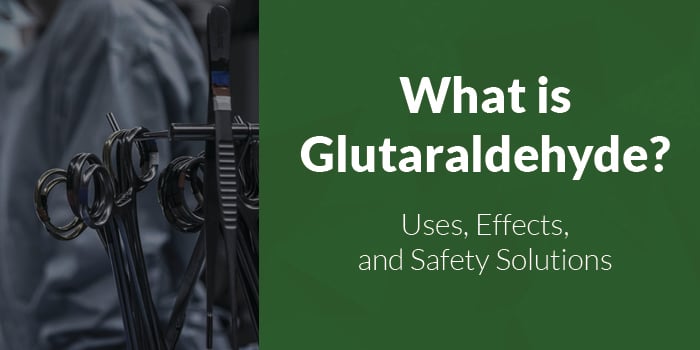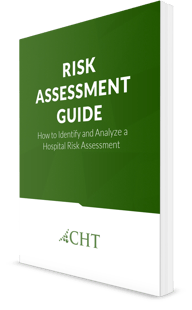
For over 50 years, glutaraldehyde has been a high-level disinfectant.
As a disinfectant, it is used to eliminate harmful microorganisms on surgical instruments and has other uses as a fixative or preservative in other parts of a healthcare facility.
However, it can get into the air from its use as a disinfectant, potentially exposing employees and patients to the chemical. Prolonged exposure to employees can become a problem.
At CHT, we provide solutions to maintain the health of your employees with environmental monitoring to ensure their well-being. We understand it's crucial to keep your employees safe and your healthcare facility compliant.
This article covers the health implications and ways to ensure chemical safety while handling glutaraldehyde in the workplace.
Are You Struggling With Medical Gas Compliance?
CHT offers medical gas services to help you reach your compliance goals. To help you navigate through these challenges, start with a free 30-minute discovery call.
How is Glutaraldehyde Used in Healthcare Facilities?
Glutaraldehyde is used as a cold sterilant to disinfect a variety of heat-sensitive instruments, such as endoscopes, dialysis equipment, and more. It is used as a high-level disinfectant for those surgical instruments that cannot be heat sterilized.
Glutaraldehyde is used for several applications in healthcare facilities:
- Disinfectant and sterilization of surfaces and equipment
- A tissue fixative in pathology labs
- A hardening agent used to develop X-rays
- For the preparation of grafts
source: NIOSH
However...
There are risks associated with exposure to glutaraldehyde.
Occupational Hazards in Healthcare Facilities
Glutaraldehyde has been linked with a variety of health effects – ranging from mild to severe – including asthma, breathing difficulties, respiratory irritation, and skin rashes (Pryor, 1984; Crandall, 1987).
NIOSH reports that workers that use the chemical can be exposed through inhalation or skin contact. Health effects can also include:
- Nasal, throat, and lung irritation
- Contact dermatitis
- Sneezing
- Conjunctivitis
Practical Solutions to Working With High-Level Disinfectants
There are safety protocols essential for healthcare facilities. Engineering controls and personal protection requirements in the American National Standard Institute (ANSI) are the standards for healthcare facilities.
As a facility manager, you want to protect your workers and lower their excessive exposure to harsh chemicals. Proper storage and use in well-ventilated rooms, personal protective equipment, and employee training are ways to mitigate exposure.
Ventilation - Section 3.4.2 of the ANSI standard cites:
"Rooms in which glutaraldehyde disinfection/sterilization is performed should be large enough to ensure the adequate dilution of vapor and should have a minimum air exchange rate of ten air exchanges per hour." [source]
If there are less than ten air exchanges, the standard states an exhaust hood should be installed to contain the vapor.
Takeaway: Ensure rooms are well-ventilated and store the chemical in closed containers in a well-ventilated area.
Personal Protective Equipment (PPE) - Section 4.2.2 of the ANSI standard
PPE protects workers against the hazards of using high-level disinfectants such as glutaraldehyde. Regardless of the type of disinfectant used, facilities should use the proper PPE designed to protect their skin and eyes from contact.
Proper PPE recommendations:
- Wear elbow-length gloves that extend up the arm for full protection
- Wear splash-proof safety glasses/goggles with full face shields (emergency eyewash equipment should be readily available)
- Wear an impenetrable gown for coverage
Controlling exposure to occupational hazards is an essential part of protecting workers. NIOSH (The National Institute for Occupational Safety and Health) recommends that employers use the Hierarchy of Controls to prevent injuries. NIOSH defines the Hierarchy of Controls, which uses control methods for a safer system.

Source: Wikimedia Commons, NIOSH Hierarchy of Controls
Training and Continuing Education - Section 5 of the ANSI standard
Updated procedures and adequate training should be applied in healthcare facilities. As new employees are hired, they must be made aware of the use and effects of harsh disinfectants.
Employees should have access to material safety data sheets, labels, and specific training for any exposed workers.
Conclusion
Chemicals play an essential part in healthcare facilities. Ensuring the safe and healthy use of these chemicals is critical.
CHT’s environmental monitoring program provides employee exposure monitoring to a wide variety of chemicals that employees and patients may be exposed to throughout a workday.
CHT offers medical gas services to help you reach your compliance goals. To help you navigate through these challenges, we offer a free 30-minute discovery call.






